Welcome to the penultimate Technical Roundup of 2018, where you’ll find a great range of important updates and new features released in November for Google, Bing, and Yandex.
Developer News
Useful Header Compression Guide Published
On 17 November Mark Nottingham published a very useful guide on how to design headers for HTTP compression using HPACK.
In his article, Mark discusses how the compression format reduces bloat on a network when new headers are designed and created – as long as the specification is followed carefully.
He also makes the very good point that HPACK is not GZIP, as it works differently, due to the fact that it uses a static Huffman coding and a lookup table that operates at the granularity of an entire header field.
By incorporating these elements, the format is far more resistant to CRIME attacks than GZIP compression. However, it brings with it an additional level of complexity.
Mark offers a very worthy step by step guide of what to incorporate into a header using HPACK, as well as what to avoid.
Read through Mark’s detailed explanation of creating the perfect header for HPACK. There aren’t a lot of guides out there on this subject, so this is a worthy read for developers making the switch from GZIP or looking to get the best efficiency out of HTTP/2.
Google News
Pagespeed Insights now Powered by Lighthouse
Writing on its Webmasters Blog on 12 November, Google announced that Pagespeed Insights (PSI) now uses Lighthouse as its engine for analysis.
The upgrade will allow developers to get aligned performance and recommendations across the web, including from performance audits, and in Chrome DevTools.
This means that from version 5, PSI API provides much more information, including CrUX data and all Lighthouse Audits. Google has stated that previous versions of the PSI API will be depreciated by May 2019.
The update means that reports are broken up into several categories, including:
- Field Data: Uses the Chrome User Experience reports and shows both the First Contentful Paint (FCP), and the First Input Delay (FID).
- Lab Data: This provides Lighthouse analysis of the current page while plotting metrics, including FCP, Speed Index, Time to Interactive, First Meaningful Paint, CPU Idle, and Estimated Input Latency.
- Opportunities: Here webmasters are shown ways to improve the performance of a specific page, including areas of issues and how they are slowing it down.
- Diagnostics: Offers a report on the performance of the application for aspects such as caching, DOM size, payloads, and JavaScript.
- Audit: Here the report demonstrates how well a website performs on audits such as Minify JavaScript, CSS, redirects and more.
The blog notes that: “The PSI v5 API now returns this new analysis together with CrUX data, and all Lighthouse category data (Performance, Progressive Web App, Accessibility, Best Practices, and SEO) for a given URL.”
The PSI tool has undergone a significant update, and it is something that all webmasters should take a look at. Have your development team look through its findings to help improve your site’s page speed.
If you’re not already using version 5 of the API, we recommend you do so before the May 2019 cutoff for earlier versions.
New Portal Launched to Help Developers
To help developers build modern, performant websites and web apps, Google has released a new portal on web.dev that measures site performance, alongside compliance standards for progressive apps, SEO, best practice, and accessibility.
The tool also shows what steps developers can make to improve their websites based on the audit and breaks down information into bite size chunks:
- Performance
- PWA
- Best Practices
- Accessibility
- SEO
A learning section has also been created so that developers can gain clarification on areas that the portal highlights. As this portal also uses Lighthouse it’s expected that you’ll find some information overlap with that offered by PSI.
If you’re a developer looking for resources on optimising your site or application’s performance and accessibility, then the portal could be an excellent jumping off point to get you thinking along the right lines.
Google Search Console Experiments With Properties Organisation
Early in November SEO Manager Tristram de Silva reported that he had access to a new feature in Google Search Console that partially replaced the old property sets with a “domain properties” feature:
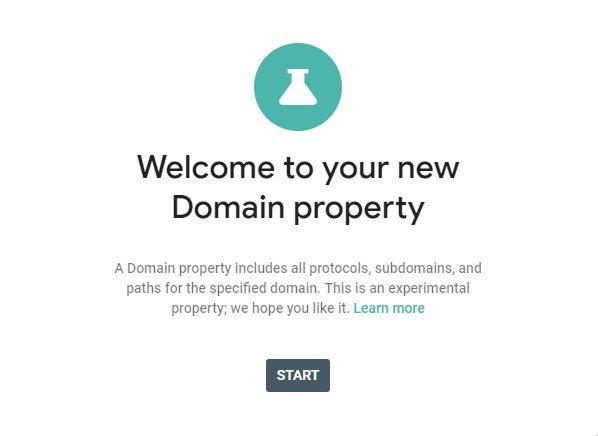
Google said that: “Search Console is experimenting with a new type of web property that includes all protocol and subdomain variations for a given domain.”
A domain property is defined as, “a bare domain or subdomain fragment, without any protocol or path. Data for all subdomains, protocols, and subpaths are aggregated for this property.”
This means that all domains will have a single aggregated picture that combines data and information so that webmasters can clearly evaluate how their sites are performing.
For the moment the feature can only be accessed by invitation, as it exists in experimental form only.
Google also stated that webmasters cannot create domain properties, as the search engine does this for them, although upon full release, it is expected that webmasters will have full control.
For the moment it is not known when the new feature will become available to the public. If by chance you have been invited to participate in the experiment, you should have received a notification in your account.
If for any reason you don’t wish to be a participant, Google has published an opt-out form.
Lazy Loading Guide Published
Google has published a best practice guide for webmasters, to help them create lazy loading objects that can be easily discovered by the search engine. This is particularly important as webmasters need to assess Google’s ability to crawl content within lazy loading patterns.
Google advises that all relevant content is loaded whenever it is visible in the viewpoint by using the IntersectionObserverAPI and a polyfill.
Additionally, when it comes to infinite scrolling, or paginating loading, a unique link must be provided to each section that users can share and load directly. When content is loaded dynamically, the History API can be used to update the URL.
Once that implementation has been set up, tests should also be carried out to ensure a page’s full functionality, and this can be done using Puppeteer Script for local tests.
Puppeteer is a Node.js library for controlling a headless Chrome browser.
Proper implementation of lazy loading pages is essential so that GoogleBot can discover content. Read the full guide and learn how to run test scripts so that you can ensure successful implementation.
While we’re here, John Mueller discussed lazy loading techniques in a Webmasters Hangout near the end of October. Read the SEO Roundtable write up, here.
Google Tests Multifaceted Featured Snippets in Desktop Results
Towards the end of October it was reported by a number of SEOs that Google had been testing multifaceted featured snippets in desktop results.
Multifaceted snippets are shown to users when queries are broad enough to allow more than one interpretation of what has been submitted to the search engine.
This means that more than one featured snippet will be returned to the user with the original query slightly amended in a way that the user may have also intended.
Google has been showing multifaceted snippets in mobile results since February since not all queries inputted by users are explicit.
Having your site show in a featured snippet can be great for traffic, so keep up to date with the evolution of featured snippets (mobile and desktop) to increase the possibility of placement in what some call “position zero.”
Changes to Google News Confirmed
After a series of complaints from webmasters being unable to find their content within Google News, Lisa Wang confirmed on 20 November that Google will be making changes so that publishers can see their content.
Wang said: “We are working on an update which should help resolve some of the issues that publishers have raised around finding their sites or particular articles in Google News.”
She continued, saying that: “We estimate this will be ready in the next few weeks and will provide another update at that time.”
If you’re a publisher that regularly has articles in Google News, keep an eye out for updates, as even if you have not been affected by the above issues, there could still be changes that you might need to consider.
Event Listings Filters Added to Google Search Console Performance Report
Towards the middle of the month a new set of filters around event markup were added within the search appearance filter in Google Search Console’s performance report.
The new filters enable webmasters to see how well event listings are performing in web search results:
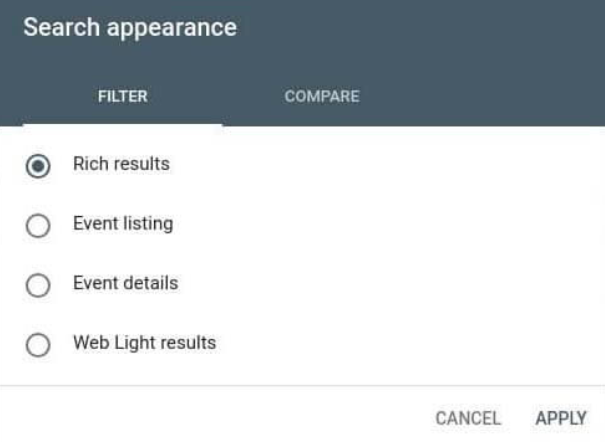
Event listings show up in Google search results when event markup has been used on pages dedicated to events.
The new data in the performance report shows a variety of important information, including clicks, impressions, position data and the URL of the provider shown in the list and details views.
The additional filters will help you understand how well your events markup is performing, and you can break the information down by individual listings or event detail pages.
Google has also explained the new metrics in a full guide.
Changes to Hotel Pack Design in Search
On 19 November Sergey Alakov noticed that Google was rolling out a new interface for local pack listings for hotels.
Using the search term “hotels near Oxford” we can see how the new pack is shown on desktop:
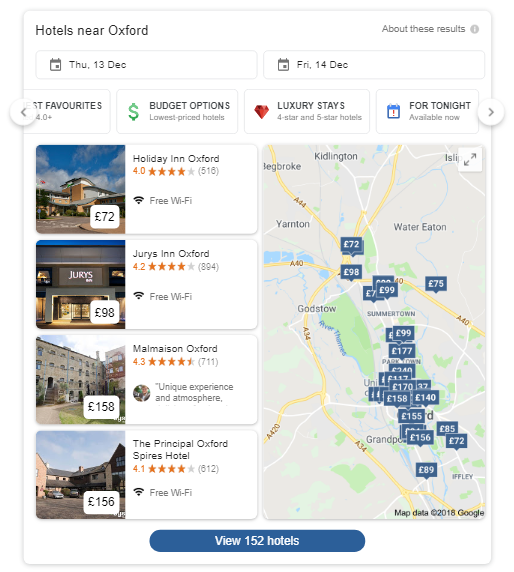
Besides the redesign, other features have also been added, such as price tags, which are being pulled from paid advertisements. This point should be of particular interest to businesses or SEOs working in the hospitality industry who aren’t currently utilising paid search.
Other information offered from the pack includes filtering options such as top choices (seen in the bar running down the side), guest favourites (accommodation rated 4+), budget options (lowest cost hotels), luxury stays (four and five star rated hotels), and for tonight (available now).
For those working in the hospitality industry, it is crucial that all website information is correct and up to date. The redesign also means that businesses must compete with yet another hotel in the pack, so consider which filter could drive the most traffic to your business.
Branded Searches Clarification Offered
As reported in our Technical SEO Roundup October 2018, Google last month introduced new analytics data in Google My Business Insights.
Named “brand” searches, they are defined as “Customers who find your listing search for a brand related to your business.
Writing on Local Search Forum, Joy Hawkins was able to meet up with Google and discuss what the different types of searches are.
Read through Joy’s post using her examples, so you get a clearer understanding of how users are finding your business through local search.
Google My Business App Revamp
On 14 November Google announced changes to its Google My Business App.
The new and improved app enjoys a range of new features including a review management section, insight analytics, profile management, Google Posts management, and real-time messaging.
The revamped app is available for both iOS and Android. Changes include:
- The ability to respond to reviews in the new Customers tab
- See results on the Home tab and how much customers are interacting with your business profile.
- The ability to make edits on your Business Profile (the box with your business information found in Google Search and Maps.
- The Tap button, which allows business owners to upload photos and offers.
- Real-time notifications for when customers are interacting with your business profile.
- Bug fixes
If you haven’t already, download the new Google My Business app and take advantage of its new features and improvements while you’re on the go.
John Mueller Confirms it is Possible to Rank in Google even if you Spam (by Mistake)
Writing on Twitter on 23 November, John Mueller confirmed that it was possible to rank in Google if you spam and break the Google’s Quality Guidelines by mistake.
He said that if a website was doing positive things elsewhere, it was still possible to rank and that, “Usually we’re just ranking them because of other factors – getting one thing wrong doesn’t mean you’ll never show up in search…”
Another user stated that they would still avoid keyword stuffing, which Mueller said was “a good approach.”
It’s never a good idea to use spammy tactics on a page or part of a website, but it does show that Google will take into account the site as a whole when considering where to rank it in SERPs.
Reading through Google’s Quality Guidelines is always worth doing as a refresher every now and again.
Bing News
Phone Comparisons and Product Insights Added to Bing Search Results
On 16 November, just one week before Black Friday, Bing announced that it was adding a series of new features in search results to help users who shop online.
For those shopping for new mobile phones, the search results will now return model comparisons directly into the search results.
Such results can be triggered by queries such as “iPhone X vs Samsung Galaxy S9”, much like the one below:
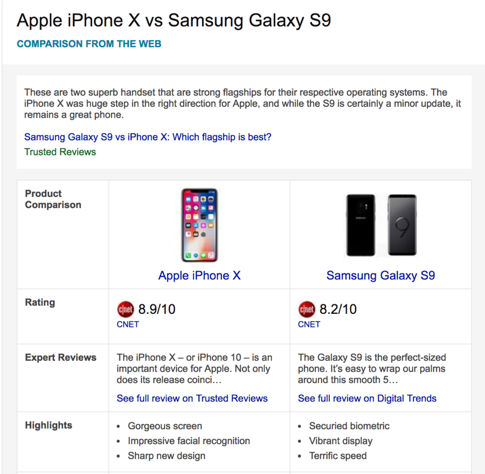
By entering such a query, users can view a range of comparable stats taken from authoritative sites and stores.
The search engine also announced that it is also to offer insights for other technology and products, such as laptops. If a user was to search for “best laptops” for instance, they would be presented with something very similar to the example below:
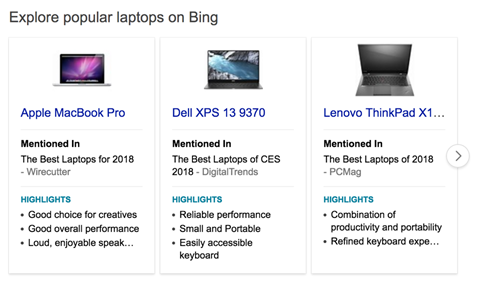
Links to relevant articles are presented, as well as key information such as product ratings, reviews, and features.
A feature that Bing rolled out especially for Black Friday was its own browsable Black Friday infographic. The media allowed users to search for specific stores and presented them with the relevant Black Friday deals.
Bing is keeping the page open throughout the holidays and it will update automatically as new deals and promotions are released.
The new comparison and product insights could drive a lot of traffic to sites that offer accurate and reliable information about a range of products. Ensure that your store offers as much relevant information as possible for a chance to appear in the new results.
Yandex News
Yandex releases Andromeda Search Update
Writing in its official blog on 19 November Yandex announced the latest update for its search engine, which has been rolled out by the search team “over the last year”.
According to the blog, over 1,000 improvements and features were added, the most notable ones being:
- The enhancement of “quick answers” in search results, including the introduction of Experts.
- Providing users with an easy way to recognise the most accurate and relevant sites within search results.
- Giving users a visual format to save searches with Yandex.Collections.
The new updates build on both Korolyov and Palekh, which were designed to improve search experiences by better understanding informal queries and search intent.
Andrey Styskin, head of Yandex.Search said: “The quality of our search is one of the key factors for the growth of our market share. And today we present a new large-scale update, which includes more than a thousand improvements. Our search team has worked on them for more than a year.”
Yandex goes into greater detail of the three major features it added in the past year within its blog, so if you have missed any, it would well be worth reading.
Yandex Announces two new Shopping Platforms
On 22 November Yandex announced that it had launched two new shopping platforms:
- Beru – dedicated to offering shoppers multiple categories on a single platform.
- Bringly – an eCommerce platform dedicated to “enhancing cross-border shopping for Russian consumers.
Beru was launched in Russia at the beginning of November and features over 1,000 retailers and 600 shopping categories. The platform also allows users to purchase medications from over 10,000 pharmacies located across Russia.
Bringly provides shoppers over four million products from around the world and offers free delivery for goods purchased from Turkey, China, and Latvia.
Maxim Grishakov, CEO of Yandex.Market said: “The Russian e-commerce market is still developing and has incredible potential for both domestic goods and cross-border sales.”
He continued: “With Beru, Yandex is using its technological developments to create a greater e-commerce experience. Through Bringly, we are excited to be providing users with even more options by delivering goods directly to consumers, as two in three Russians make cross-border purchases online.”
Both platforms are to be added to Yandex.Market, so if you’re a business that operates on that platform, it should be worth investigating how this could affect you and what new opportunities have been afforded by Beru and Bringly.
Additional Reading
Google Tests Dropping Knowledge Panel
Writing in the Google Web Search Help forum near the end of November, Andy B., a search community manager confirmed that Google was experimenting with removing the knowledge panel as part of an experiment.
Instagram Allows Users to Create alt Tags for Photos
Instagram is now allowing users the ability to create alt tags for photos in Feed, Explore, and Profile.
Only use one URL for Seasonal Content
In a Webmasters Hangout John Mueller recommended that sites with seasonal rotating content should keep it contained all within one URL. Read the transcript of his advice on Search Engine Journal.
